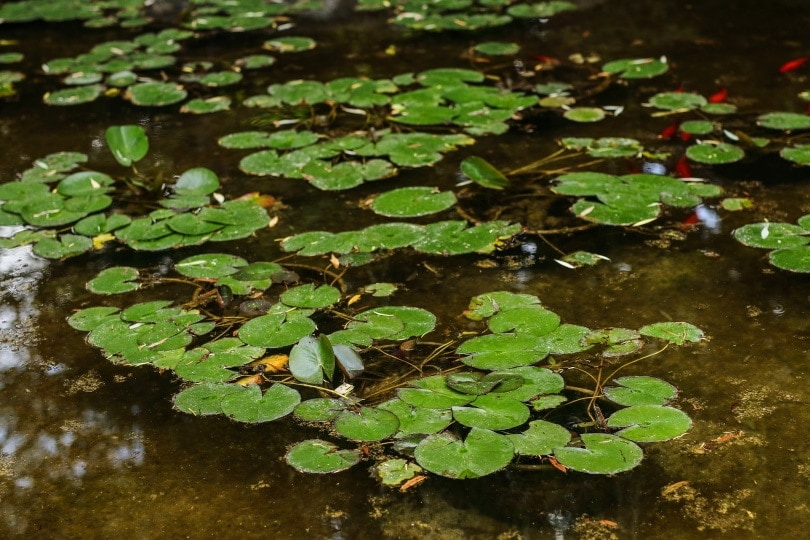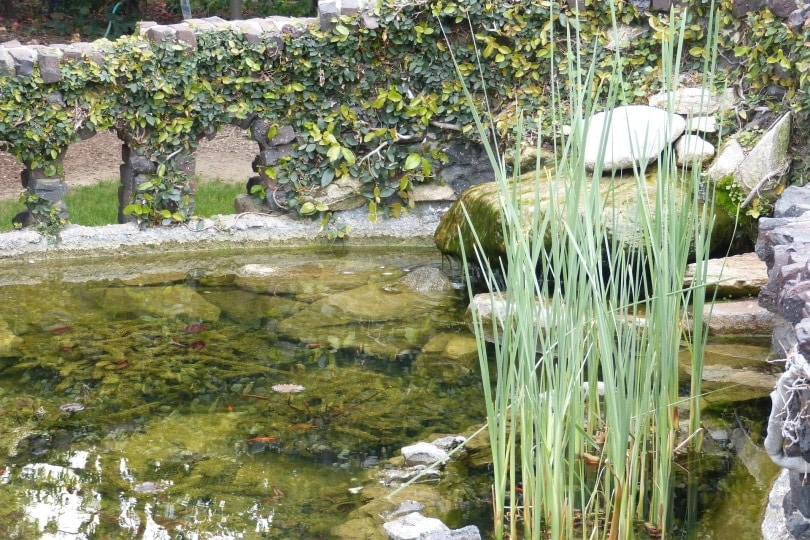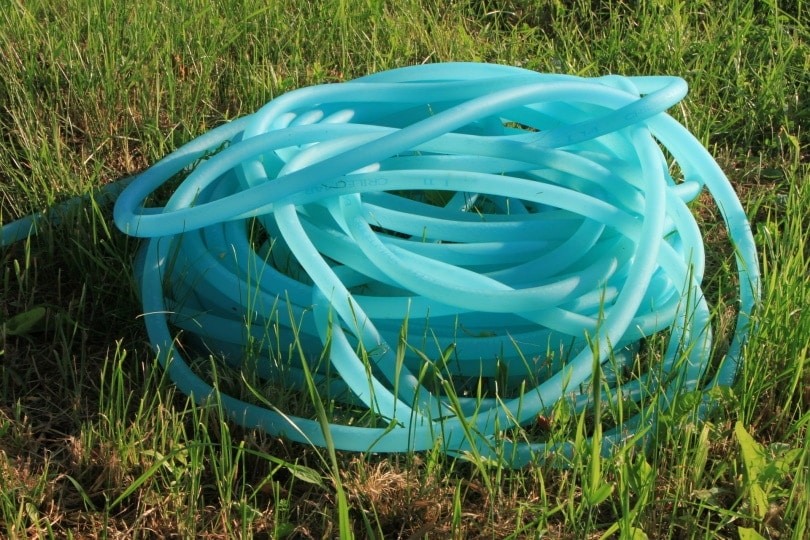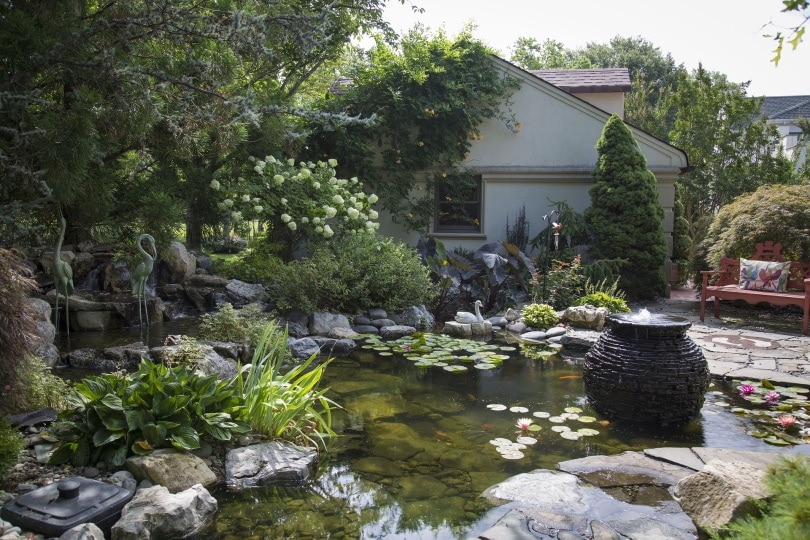Draining a pond may seem like a daunting task, but it isn’t too complicated to carry out. You may not even need to do it. Though using a pump to remove water from your pond is preferable, you can empty a pond without a pump as well (it will just take longer). Are you ready to find out all there is to know about draining a pond? Let’s get down to it.

First, Do You Need to Drain Your Pond?
Don’t go rushing out to drain that pond just yet. You should first seriously consider whether you need to drain the pond. The pond’s natural ecosystem, which contains all kinds of bacteria, organisms, plants, and animals, takes a long time to establish itself. If you drain the pond and refill it, you will be forcing the pond to start over, and it could take a while to get it back to its normal state.
Great care should especially be taken if you house fish in your pond. The water must be maintained at a healthy Ph level, as well as be kept free of nitrites and ammonia. If the water is at a good level now, it might take a lot of trial and error to get it back to the previous levels.
If your pond is just dirtier than it should be, there are many ways to clean your pond. You could invest in a pond rake, vacuum, or create your own pond filter to get it cleaned up and maintained without disturbing the entire pond ecosystem.

Reasons to Drain a Pond
While it’s best to keep the pond water you already have clean and balanced, sometimes you just have no other choice but to drain the water all out. Here are a few cases when draining the water might be necessary:
- Changing the water heavily
- Repairing or replacing a pond liner
- Moving fish
- Pond reconstruction
- Getting rid of a pond
- Checking fish for illness or injury
Before You Start
Once you decide that you need to drain your pond water, you then have to figure out where to drain the pond water. Maybe your pond already has some natural runoff, and that isn’t a problem, but if you’ve only got limited yard space, it could be a difficult thing to figure out.
If you have a garden or yard, water it with your pond water. It’s rich in nutrients that plants love, so don’t let it go to waste. Give the trees some of the water, too, which can absorb water on their own. If you’ve watered everything around your house (don’t forget flowers), fill up several buckets for watering later.
After the pond’s empty and you’ve finished your tasks, you should prepare what you need to fill up the pond again. Plan to treat the water before reintroducing plant and aquatic life and add good bacteria back in, otherwise, your fish and plants may not survive the water change.

How to Drain a Pond with a Pump
Pond Pump
The easiest way to drain a pond is with an aquatic pump. If you filter your pond water, you likely already have a pump. To do this with a submersible pump, simply place the output hose wherever you want the water to go and place the pump at the deepest part of your pond. Make sure the pump can handle the depth of your pond by checking the maximum head height on the pump. The higher the number, the deeper the pump can be while continuously working.
With an external pond pump, you will have to adjust the intake line if it has a fixed intake. Do this by installing an extension hose and putting it in the deepest part of the pond. Then, just like the submersible pump, put the outtake hose wherever you want the pond water to go.

Solar Pump
Solar pond pumps are made for shallow ponds and usually for water features like fountains or waterfalls. It’s possible to drain a small-sized pond with a solar pump, but it will take longer than an electric pump. This method is best for draining ponds in remote locations that may not have access to electricity, however, it’s still preferable to use an electric pump.
Hand Pump
If you’re looking for a killer upper-body workout, skip the gym and try draining your pond with a hand pump. A good hand pump should pump out 5–10 gallons per minute. So, if you know how many gallons of water your pond holds, you can do some math and will have a good idea if a hand pump is a realistic option.

How to Drain a Pond Without A Pump
Pond Vacuum
A pond vacuum is normally used to clean pond muck and debris, but it can also be used to drain pond water. Before you start, make sure your pond vacuum has an adequate discharge system. That means that the pond vacuum can suck up and discharge water at the same time, otherwise you will have to toggle the switch every time your vacuum fills up with water. You will also want the discharge hose to be nice and long so you can empty the water where you want to.

Bucket
It’s old-fashioned but is still an effective method to empty pond water. It’s best used for small ponds and relies on a 5-gallon bucket dipped into the water and dumped out of the side.
Siphon Hose
Put the siphon hose in the deepest part of the pond, and use a hand pump to suck water from the pond through the hose. Once the water reaches the other end, you can stop pumping, and the water will siphon out freely.
Garden Hose
If you don’t have a siphon hose, a garden hose can work just the same. You will need a garden hose, a nozzle for one end, and a spigot for the other.
First, put the hose on the spigot and the nozzle on the other (in the closed/off position) end. Turn on the spigot to fill the hose completely with water. Turn off the spigot and take off the hose without letting any water escape (you can do this by holding it vertically as quickly as possible). Take the hose to the spot where pond water will be drained and leave the nozzle end there. Then, take the open end to the deepest point in the pond. Secure the hose with a large rock or brick (while still allowing water to flow through). Release or turn on the nozzle end, and water should rush out freely.


Final Thoughts
After your pond is drained and refilled, remember to treat the water properly before reintroducing plant and aquatic life. Chlorine can especially be harmful to fish. Water treatment can be done with dissipation time, a water conditioner, or special products that add good bacteria back into the pond.
- See Also: How To Kill Mosquito Eggs In Ponds
Featured Image Credit: PondGuy, Pixabay
